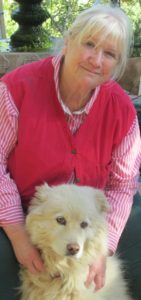
I am driving to Thousand Oaks on the 101 at dawn. The road is an unclogged artery. Yo Yo Ma is playing “The Eternal Vow.” I slide up the highway thinking how good it was to be young, to have pristine blood vessels unfettered by plaque. I imagine laughing blood cells drag racing through young bodies, oxygenating elastic, spring-loaded muscle.
My 95-year-old mother is waiting at the end of this early morning journey, as sharp as a 20-year-old but carrying a heart that has been trying to leave for a while. I am thankful to the technology that is going to give her more time—to write, to laugh, to tell stories to great-grandchildren-to-be.
She already has a pacemaker. With that amazing device to keep her harmonious heart on metronome time, she came off all blood pressure meds. But her aortic valve is very old and very tired, the opening dangerously narrow. It needs replacement or, a slow, suffocating, lights-out. Previously, this meant cracking the chest and putting a patient on a heart-lung machine to replace the valve, not offered to most elderly patients who can’t tolerate such harsh surgery. Since 2011, however, a modern technology wonder called TAVR (Transcatheter Aortic Valve Replacement) has been making valve replacement practically an outpatient procedure.
One of the best kept secrets in Los Angeles is the TAVR program at Los Robles Hospital in Thousand Oaks. Medical Director of Cardiac Services, Dr. Vishva Dev and Dr. Gregory Fontana, Director of the Cardiovascular Institute of Los Robles Hospital, are the physician/magicians taking my mother “behind the curtain.” Dr. Dev is an interventional cardiologist. Gregory P. Fontana, MD, is an international leader in cardiothoracic surgery, whose primary professional focus has been on less invasive treatments of structural heart disease.
Together, they thread a catheter up to my mother’s heart through a femoral artery. They insert a beautiful, healthy pig valve, crushing the old, calcified, narrowed valve to the sides. After only an hour, my mother is wheeled to the CCU with a new aortic valve pumping steadily. It is so modular!
The doctors are as gleeful as schoolboys, delighted for another success with their new procedure.
The CCU has a digital glow. Screens scroll information in neon blues, reds and dark yellows. The unit has a digital sound, a rhythm of beeps and tones underscored by whooshing compressor notes.
While my mother sleeps in sedated oblivion, her body communicates her vital information through electronic connections. She is constantly scanned by software that sorts and analyzes her progress and warns us when we need to make a pro-active move. I cannot get over that she has a new aortic valve in hardly more time than it takes to go through a car wash.
Two days later, we are in the rehab hospital. My mother and I are hysterical. She has opened her dinner, recoiling with horror: “Oh! That’s spooky!” On the plate, it looks like someone has thrown up onto a bed of lettuce. It feels so good to laugh, I almost cry.
We sort through her medicine list and therapy plans. I can check each medication with my smart phone, looking for information on adverse reactions. I call up her electronic medical records (EMR) to find the name of a cream we forgot to bring over from the main hospital. Every test, every medication, every note is available to us. It helps us be good partners in my mother’s care. We also look up recipes for a low-salt diet, because the blueberry pancakes they brought Mom that morning looked like “rubbery cow dung” and were only fit to fly as gastronomic Frisbees.
At 95, my mother still uses a flip phone. Don’t laugh. They work. We are directly connected. She can punch one key and call me for help, day or night. I could put a camera I just got for the Floating Doctors center in Panama in my mother’s room. This camera can broadcast to my smart phone, wherever I am, with sound! If I start worrying about what is happening at night to my mom, I could easily have her in my vision right on the pillow next to me. It is a wondrous world.
Congestive heart failure is a horrible way to die. My mom has dodged that bullet with modern technology and the heroes who operate it. But the best moment is taking her outside. I wheel her into the fresh air. She breathes in, as deeply as she can. I turn her to face the sun, her chin is raised, she soaks in the warmth. The breeze feels like velvet on her skin. Birds sing a Hallelujah chorus. The natural light, sound and air trigger a cellular, soul-filling bliss.
Vamos a ver, my beautiful Mom!
Paula LaBrot is a 30-year resident of Topanga, a futurist with a special interest in the uncharted waters of cyber space.


